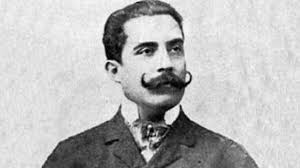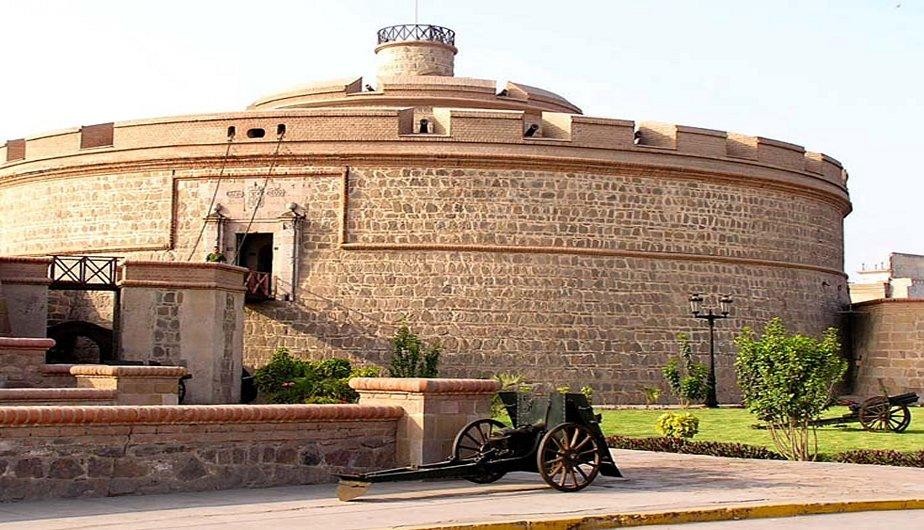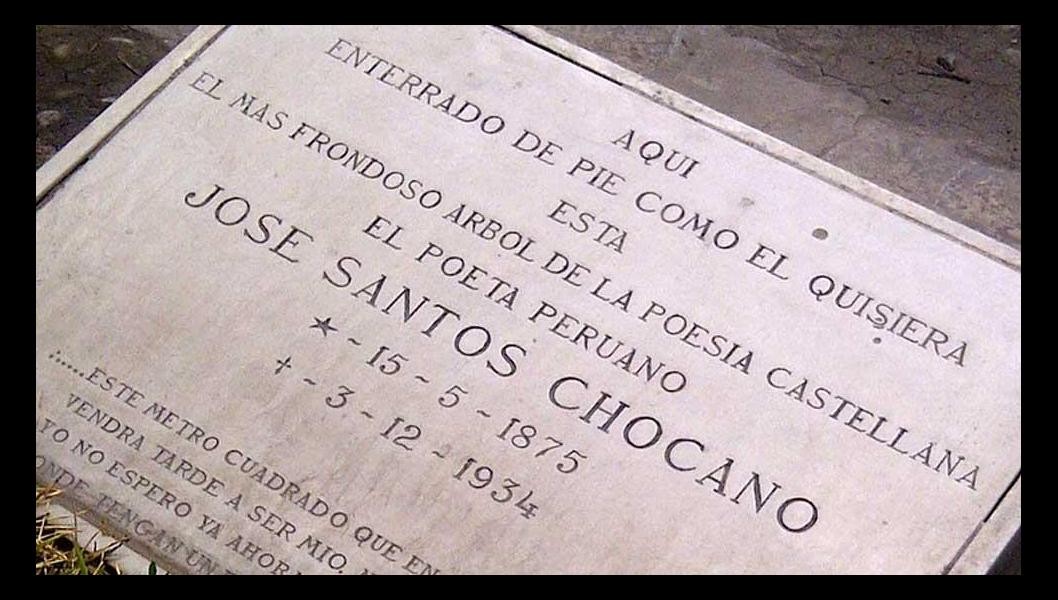Jose Santos Chocano: the Life and Locations of the Poet of America
Hello everyone!
I hope that each one of you is well.
In this post, we are going to be talking about the life of a unique poet with an enormous talent known as The Singer of America. He died, tragically murdered on a tram in Santiago de Chile, do you know who I'm talking about? Of course, its no other than José Santos Chocano.
In the centre of Lima, like in all the diverse places in Peru, we can find a sculpture of this Peruvian man who shook his country through his work: he is the most famous Peruvian figure from the first half of the 20th century, his turbulent life is found written within his verses and is seemingly misunderstood by his own society.

José Santos Chocano was born in Lima on the 14th May 1875. His father left him to fight in the war with Chile, and it is said that his mother was a very strict woman, and because of this strict upbringing it is widely thought that José Santos Chocano was extremely patriotic.
The family of José Santos Chocano lived in what is now known as Cayoma street in the centre of Lima, two blocks from the Government Palace. José Santos Chocano was born and grew up in a difficult time of recession during the war with Chile, Lima was at a stand-still and relatively in crisis.

After he reached six years old, José Santos Chocano witnessed the Chilean occupation of Lima. Let me show you a phrase from his own summary of his childhood: "the first thing I had in this life, was death. From then on, I have familiarised myself with living, although I am eager for some of that tranquility in this atmosphere of tragedy. I did not run, I did not laugh, I did not play, I did not have a normal childhood" - José Santos Chocano, Memories 1940.
José Santos Chocano started at a German college and the Lima Institute, and it was here that he made a friend - the son of Ricardo Palma. When he graduated from college, he decided to enroll in the University of San Marcos (my university), but he did not finish his studies.
This was a generation that lived through the horrors of the Pacific War and who had a spirit fueled by revenge and the desire for restoration. In 1892, at barely 17 years old, José Santos Chocano wrote against the governemnt under a pseudonym in order to avoid being found out.

José Santos Chocano was recognised and became reprimanded and encarcerated in the Fortress of Real Felipe, where the poet suffered for some months. History tells us that José Santos Chocano started to get to know the man who would later become President: Oscar Benavides.
If you go to the Fortress of Real Felipe, you will find where he was incarcerated, which now is a weapons warehouse. Some time later, José Santos Chocano was released and continued to write for the written press.

It was in the Peruvian printing house that José Santos Chocanob started to publish his first novels, but we would not be recognised as a modernist author, but as a distinctly personal kind of writer.
In 1896, José Santos Chocano published his third book "Azares" in honour of his first wife (out of three in total).
In 1901, José Santos Chocano was named consul of Central America, in which time he was placed on the relevant issue of the Tacna and Arica Campaign, which he started to find support for and friends to help with an eventual negotiation. After this, he returned to writing in the year 1921 to work on more of his works such as "Poesías Completas" - his complete works of poetry.
In 1905, José Santos Chocano began his trip to Europe and started to contact different writers of the period, already in Madrid, he published "Alma América" - "American Soul".
Here we have an example of his poem "Blasón" from "Alma América" in Spanish and the English translation:
"Soy el cantor de América autóctono y salvaje:
mi lira tiene un alma, mi canto un ideal.
Mi verso no se mece colgado de un ramajecon
vaivén pausado de hamaca tropical...
Cuando me siento inca, le rindo vasallajeal Sol,
que me da el cetro de su poder real;
cuando me siento hispano y evoco el coloniaje
parecen mis estrofas trompetas de cristal.
Mi fantasía viene de un abolengo moro:
los Andes son de plata, pero el león, de oro,
y las dos castas fundo con épico fragor.
La sangre es española e incaico es el latido;
y de no ser Poeta, quizá yo hubiera sido
un blanco aventurero o un indio emperador. "
English translation from an online source:
"I am the untamed voice of native America,
my lyre has a soul, my song an ideal.
My verse is not cradled and hung in the foliage
with the paused to-and-fro of a tropical hammock…
When I’m feeling Inca, I pledge my vassalage
to the Sun, who offers the scepter of his royal power
when I feel Hispanic and evoke colonial slavery
my verses sound like crystal trumpets.
My fantasy hails from Moorish lineage:
the Andes are of silver, but the Lion – of gold,
and the two are alloyed with an epic roar.
The blood is Spanish and the pulse is Inca;
and if not a Poet, I might well have been
A white adventurer or an Indian emperor. "
Without a doubt, "Alma América" was José Santos Chocano's most important work which earned him the title of an excellent poet: he was considered "the Poet of Peru" and his brilliant poems were a new tie between Spain and America.
Just like people who supported him and valued his work, there were also critics. I am referring to José Carlos Mariátegui who said that José Santos Chocano was a man from the coast influenced by Spanish literature and therefore could not represent an native.
José Santos Chocano had another poem in which he spoke about Spanish horses, which maybe was the one that José Carlos Mariátegui was in disagreement with, as this poem overflows with love for the heroes of the conquest and not for the Native Americans of Peru.
However, despite the fact that I am more inclined to agree with Jose Carlos Mariátegui, it cannot be denied that José Santos Chocano's poems speak of nature in other verses, and his rhythm and variation of repetition is simply music to the ears.
Satying in Spain, José Santos Chocano was linked to a fraud scandall which was established in Mejica beginning to spread even to Pancho Villa.
From Mexico to Guatemala where José Santo Chocano was sentenced to death but saved by an intervention from his own father and various other presidents of the region and of Europe. Miraculously, José Santos Chocano was saved from death.

In 1921, José Santos Chocano returned to Peru and is received by the intellectuals of the time, he was honoured amazingly in plazas and theatres of Lima, he had spent almost 17 years away from Peru and during this time he had transformed into a continental figure.
On the 5th November 1922 the municipality of Lima gave an award with the title "Poeta de America", "Poet of America". This generated a bit of stir at the time, as there were people who disagreed with the award because José Santos Chocano had kind of supported organized dictatorships, but in the end, art was separated from the ideological problem. In what is today called the Park of Lima precisely where the Palace of the Exhibition was, José Santos Chocano was awarded a full laurel of gold. When accepting the award, he said "blessed are the people who love their poets, because within them is the king of immortality".
The acknowledgment that José Santos Chocano received made him one of the most important poets, no other Peruvian poet had ever received as much recognition in their lifetime as José Santos Chocano did.
José Santos Chocano became a strong supporter of the President Augusto Leguía, showing his inclination for power and his celebration of organised dictatorships.

The National Pantheon of Heroes was created in 1924, where, at the time of its creation, José Santos Chocano decided to look into the lives of each one of the heroes. It is even said that he got in contact with spiritualists in order to communicate with them.
For this occasion, in 1924 he wrote “Ayacucho en los Andes”, "Ayacucho in the Andes", where he invited many different poets to celebrate the event.
José Santos Chocano always maintained his firm support of American dictatorships, which logically, prompted many opinions again the Singer of America. One of these opinions came from Mexican José Vasconcelos, who wrote an article criticising the intellectuals who supported these kinds of dictatorships.
José Santos Chocano felt alluded to and even parodied Vasconcelos's name as "Vas con celos" meaning "go with jealousy". Despite this, there were many Peruvians who supported the Mexican, including the great José Carlos Mariátegui.
As we have seen up until now, José Santos Chocano was a very strong character. One of his other opponents was Edwin Elmore, and one day they found themselves in the old building at the centre of Lima. It is said that José Santos Chocano shot Edwin Elmore in this altercation where two days later, he died.
José Santos Chocano did not end up in jail as a result of this altercation because he had the support of Augusto Leguía since he started to write against the son of the man who had died. In this judgment, José Santos Chocano tried to get the jury on his side, and remember that he was very good with words.
In July 1926 they condemned him to three years in prison, but after countless problems he was finally freed. On leaving, very few Liman people supported him so he had no choice but to leave the country.
His destination after what had happened, was Chile. In a letter to a friend, José Santos Chocano mentioned that "you know that I am going to Chile, Argentina, Patagonia, anywhere, because I cannot continue, confusing myself with my countrymen, I will return when I can civilize them with my diary".
Despite the recognition in Chile, misfortune pursued the poet, through emotional problems and particularly in poverty, even having to sell his golden laurels that he received in his awards.
On the afternoon of the 13th of December 1934, whilst traveling on a tram into the city of Santiago de Chile, he was murdered by a 60 year-old man, and the entire continent was shocked by the death of José Santos Chocano.
José Santos Chocano was a very superstitious man, so much so that it is even said that he read his future knowing that his death would be tragic, but not expected so soon.
Some time after, his remains were transferred to Lima and they were buried in the cemetery Prebistero Matías Maestro. On his tombstone you can read the following sentence: “Aquí enterrado de pie como él quisiera está el más frondoso árbol de la poesía castellana, el poeta peruano José Santos Chocano” - "Here buried as he would like, is the most lush tree of Spanish poetry, the Peruvian poet José Santos Chocano".

"This square meter that I have searched for on earth, will later come to be mine, Dead, at last, I will have it. I do not wish for more than a square meter where I have a day to bury myself standing" - José Santos Chocano, Vida Naufraga.
Love or hate him, he was a key author in Peruvian literature, he was a man who fought for his dreams.
I hope that you have enjoyed this life account of the Peruvian man who left a mark on national literature.
I will see you in my next adventure! Thank you for reading, until next time!
Photo gallery
Content available in other languages
Want to have your own Erasmus blog?
If you are experiencing living abroad, you're an avid traveller or want to promote the city where you live... create your own blog and share your adventures!
I want to create my Erasmus blog! →























Comments (0 comments)